Brazil, a land of magic and richness, boasts a unique culture and passionate people.
It also harbors one of nature's most spectacular masterpieces - the Caracol Falls.
Majestic Panorama of the Waterfall
Nestled in northern Brazil as part of the Amazon rainforest, the Caracol Falls stands as a colossal waterfall, among the largest and most awe-inspiring globally, showcasing the epitome of natural beauty.
The Caracol Falls spans the border between Brazil and Venezuela, boasting a total width of 4,500 meters and a staggering vertical drop of 979 meters.
Comprising 275 individual fountains, it creates a colossal water curtain, resembling a masterpiece of nature that beckons tourists from every corner of the globe with its majestic and awe-inspiring momentum.
The most spectacular segment of the Karakol Falls is the "Kyal Falls." Enormous volumes of water cascade vertically from a cliff edge nearly a thousand meters high, generating a mist that permeates the sky, akin to a water dance.
This spectacle is not only breathtaking but also conveys the sheer power and grandeur of nature.
A Diverse and Lush Ecosystem
Surrounded by the dense Amazon rainforest, the Caracol Falls is situated in a unique ecosystem teeming with plant and animal life.
The mist generated by the waterfall nourishes the surrounding vegetation, transforming the area into a thriving tropical rainforest. Various species inhabit this jungle, including unique birds, mammals, and insects.
The region around Caracol Falls is also a habitat for numerous endangered species, such as jaguars, sloths, and jungle armadillos. Preserving the ecological balance of this area is pivotal for sustaining the stability of the entire Amazon ecosystem.
Hence, multiple conservation organizations and government agencies actively work towards protecting the environment surrounding Karakol Falls, ensuring the perpetuation of this natural wonder.
Cultural Significance and Legends
The Caracol Falls holds deep cultural significance in the hearts of its residents. Many indigenous people consider the falls a sacred place intertwined with their beliefs and traditions.
Legends about the waterfall are passed down orally, narrating stories of gods bestowing life upon the waterfall or depicting it as a medium for dialogue between indigenous people and the spirits of nature.
Around the Caracol Falls, visitors can immerse themselves in the rich cultural atmosphere and gain insights into the traditional lifestyle of the residents. Some local communities derive income from tourism, enabling them to better protect and maintain the natural environment.
Tourism Experience and Sustainable Development
As the global popularity of Caracol Falls continues to rise, thousands of tourists flock here to experience this natural marvel firsthand.
To balance the relationship between tourism activities and environmental protection, the Brazilian government and local communities have implemented a series of measures to promote sustainable tourism development.
While marveling at the waterfalls, tourists can actively participate in ecological protection and community development projects. This experiential approach not only deepens visitors' understanding of the land but also provides sustainable economic benefits to local communities.
Simultaneously, the establishment of protected areas and restrictions on tourist flow contribute to safeguarding the ecosystem around the waterfall, maintaining its original natural state.
Caracol Falls captivates tourists worldwide with its majestic scenery and a rich and diverse ecosystem. However, along with admiration comes the responsibility to protect and preserve this unique natural wonder.
Through sustainable tourism and environmentally friendly measures, we aspire to see Caracol Falls continue to display its splendor for generations to come, becoming a timeless masterpiece of nature.
Embracing the concept of harmonious coexistence between tourists and nature, Caracol Falls will persist in shining brightly in people's hearts, solidifying its status as an indispensable part of Brazil.





